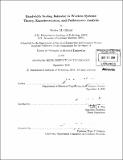Bandwidth scaling behavior in wireless systems : theory, experimentation, and performance analysis
Author(s)
Gifford, Wesley M. (Wesley Michael), 1979-
DownloadFull printable version (13.73Mb)
Other Contributors
Massachusetts Institute of Technology. Dept. of Electrical Engineering and Computer Science.
Advisor
Moe Z. Win.
Terms of use
Metadata
Show full item recordAbstract
The need for ubiquitous wireless services has prompted the exploration of using increasingly larger transmission bandwidths often in environments with harsh propagation conditions. However, present analyses do not capture the behavior of systems in these channels as the bandwidth changes. This thesis: describes the development of an automated measurement apparatus capable of characterizing wideband channels up to 16 GHz; formulates a framework for evaluating the performance of wireless systems in realistic propagation environments; and applies this framework to sets of channel realizations collected during a comprehensive measurement campaign. In particular, the symbol error probability of realistic wideband subset diversity (SSD) systems, as well as improved lower bounds on time-of-arrival (TOA) estimation are derived and evaluated using experimental data at a variety of bandwidths. These results provide insights into how the performance of wireless systems scales as a function of bandwidth. Experimental data is used to quantify the behavior of channel resolvability as a function of bandwidth. The results show that there are significant differences in the amount of energy captured by a wideband SSD combiner under different propagation conditions. In particular, changes in the number of combined paths affect system performance more significantly in non-line-of-sight conditions than in line-of-sight conditions. Results also indicate that, for a fixed number of combined paths, lower bandwidths may provide better performance because a larger portion of the available energy is captured at those bandwidths. The expressions for lower bounds on TOA estimation, developed based on the Ziv-Zakai bound (ZZB), are able to account for the a priori information about the TOA as well as statistical information regarding the multipath phenomena. The ZZB, evaluated using measured channel realizations, shows the presence of an ambiguity region for moderate signal-to-noise ratios (SNRs). It is shown that in a variety of propagation conditions, this ambiguity region diminishes as bandwidth increases. Results indicate that decreases in the root mean square error for TOA estimation were significant for bandwidths up to approximately 8 GHz for SNRs in this region.
Description
Thesis (Ph. D.)--Massachusetts Institute of Technology, Dept. of Electrical Engineering and Computer Science, 2010. Cataloged from PDF version of thesis. Includes bibliographical references (p. 167-174).
Date issued
2010Department
Massachusetts Institute of Technology. Department of Electrical Engineering and Computer SciencePublisher
Massachusetts Institute of Technology
Keywords
Electrical Engineering and Computer Science.